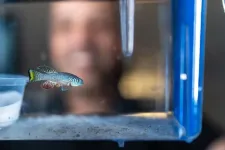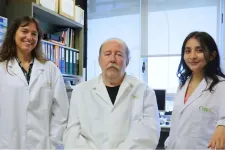(Press-News.org)
Nanoparticles (NPs) are often used to reduce environmental pollution by targeting harmful chemicals in soil and water that are released by industrial and agricultural activities. These NPs are engineered to absorb, degrade, or neutralize these pollutants, providing a potential solution to environmental contamination. However, when released into the environment, they can be consumed by organisms and transferred through the food chain, resulting in widespread toxicity.
To address this issue, a research team led by Research Professor Masazumi Fujiwara and Assistant Professor Yajuan Zou from Okayama University in Japan has developed a polymer coating that can be applied to NPs to prevent ecotoxicity. By altering the surface chemistry and electric charge of NPs, their binding properties can be modified. Introducing hydrophilic groups to the NP surface creates a barrier, deterring binding to biological molecules and cell surfaces.
While positively charged NPs are known to accumulate more in organisms due to their attraction to negatively charged cell surfaces, recent reports suggest that negatively charged NPs may accumulate more than their positively charged counterparts. In their study, which was published in the journal Chemosphere on May 7, 2024 and was made available online on April 20, 2024, the researchers developed a polyglycerol (PG) coating with the negatively charged group. This coating was applied to iron oxide NPs (ION) and was found to effectively reduce the accumulation of iron oxide particles in Caenorhabditis elegans, a nematode widely used as a model organism in environmental chemistry.
This research was co-authored by Prof. Fujiwara, Dr. Zou, and Dr. Yuta Nishina from Okayama University, Dr. Yutaka Shikano from Tsukuba University, and Dr. Naoki Komatsu and Dr. Eriko Kage-Nakada from Kyoto University.
“We have demonstrated that PG grafting was an effective approach to reduce the accumulation and to suppress the translocation of ION in C. elegans, which consequently alleviated the toxic outcomes such as reproductive potential and survival ratio,” says Dr. Fujiwara.
The researchers applied polyglycerol coating to ION of various sizes—20 nm, 100 nm, and 200 nm—to create ION-PG, aiming to assess the coating's efficacy across a spectrum of NP sizes. The ION-PG were then suspended in a solution, and C. elegans nematodes were introduced. The worms were at different lifecycle stages (from larvae to adult worms), allowing the researchers to monitor NP accumulation throughout their development. A control group was exposed to a suspension containing uncoated ION. After 24 hours of exposure, the worms were collected, washed, and examined for accumulated NPs within their bodies.
The PG coating prevented NPs from sticking to biomolecules, allowing them to pass through the nematode’s intestine more freely and be excreted from their bodies. Nematodes exposed to ION-PG had lower levels of NPs in their bodies compared to the control group. The smallest NPs, which could readily traverse through the worms, were not detected.
The researchers further investigated the impact of charge groups on NP bioavailability. They introduced positively charged amino groups and negatively charged carboxyl and sulfate groups to the ION-PG and conducted the experiment again. They found that negatively charged particles passed through the worm more easily than positively charged particles due to high electrostatic repulsion against the negatively charged cell surface and low affinity to biomolecules in the nematode.
As a result, the coating mitigated the toxicity associated with ION-PG. The researchers observed improvements in both reproductive capacity and lifespan among the group exposed to the ION-PG compared to the group exposed to uncoated NPs.
The researchers underscore that the developed coating can also be applied to other NPs such as graphene oxide and titanium dioxide used for environmental remediation. "Our findings are expected to promote the design and production of large amounts of eco-friendly nanomaterials for environmental applications," says Dr. Fujiwara.
This advancement holds promise for addressing environmental challenges and aligns with the UN Sustainable Development Goals, particularly Goal 3 (good health and well-being) and Goals 14 and 15 (conservation of water and land).
About Okayama University, Japan
As one of the leading universities in Japan, Okayama University aims to create and establish a new paradigm for the sustainable development of the world. Okayama University offers a wide range of academic fields, which become the basis of the integrated graduate schools. This not only allows us to conduct the most advanced and up-to-date research, but also provides an enriching educational experience.
Website: https://www.okayama-u.ac.jp/index_e.html
About Research Professor Masazumi Fujiwara from Okayama University, Japan
Masazumi Fujiwara is a Research Professor at Okayama University, Japan, focusing on the application of quantum technology in biology, materials, and device fields. He holds a PhD in physics and leads the Nanochemistry Lab at Okayama University, where research areas include Nanometrology, Nanodiamond Quantum Sensors, Analytical Chemistry, Physical Chemistry, and Photonic Devices. Dr. Fujiwara has held various academic positions since 2004, including roles at Osaka City University, Humboldt-Universität zu Berlin, and Hokkaido University. He has served on committees of the Physical Society of Japan (JPS) and is a member of the S&T Experts Network of the National Institute of Science and Technology Policy (NISTEP).
END
The Wyss Institute for Biologically Inspired Engineering at Harvard University announced today that Circe, a startup developed at the Institute and spun out of Harvard, has signed a worldwide, exclusive licensing agreement coordinated by Harvard’s Office of Technology Development (OTD) to commercialize a novel bioproduction technology that could significantly reduce the carbon emissions of industries from food to aviation fuel.
Circe has raised more than $8 million to date from investors including Regen Ventures, Undeterred Capital, Ponderosa Ventures, Bee Partners, and Elementum Ventures.
“One of the great challenges ...
PULLMAN, Wash. – A parasitic worm that can infest the brains of moose appears to be playing a role in the decline of the iconic animal in some regions of North America.
Moose populations have been dwindling for years across the country due to many contributing factors, but new research at Washington State University has found the impact of Eleaophora schneideri, also known as the arterial worm, has likely been underestimated.
Researchers examined recently deceased Shiras moose in Idaho between March 2020 and July 2022. While the parasitic roundworm E. schneideri was not detected in any of the animals found in north Idaho, it was present in 10 of ...
A new study demonstrated parity between a minimally invasive procedure to replace the aortic valve in the heart—transcatheter aortic valve replacement (TAVR)—and surgical aortic valve replacement (SAVR).
In the meta-analysis of seven randomized trials, published in JSCAI and presented at the 2024 EuroPCR conference in Paris, France, researchers compared the outcomes of 7,785 patients undergoing TAVR (a procedure that delivers a new aortic valve into the heart through a catheter) to those undergoing SAVR for severe aortic stenosis. ...
The study revealed unexpected and sex-specific effects of germline regulation on longevity and somatic repair in vertebrates. Contrary to classical evolutionary theories, it turns out that changing how the germline (the part responsible for reproduction) works can have different effects on males and females. This challenges conventional beliefs that reproduction and longevity are linked by a limited pool of resources. The research opens up new possibilities for understanding how our bodies age and the role of reproduction in that process. The findings ...
The SPECULOOS project, led by the astronomer Michaël Gillon from the University of Liège, has just discovered a new Earth-sized exoplanet around SPECULOOS-3, an "ultracool dwarf" star as small as Jupiter, twice as cold as our Sun, and located 55 light-years from Earth. After the famous TRAPPIST-1, SPECULOOS 3 is the second planetary system discovered around this type of star.
Ultra-cool dwarf stars are the least massive stars in our Universe, similar in size to Jupiter, more than twice as cold, ten times less massive and a hundred times less ...
Two Cancer Research UK-funded studies from Oxford Population Health have discovered proteins in the blood that could warn people of cancer more than seven years before it is diagnosed.
Scientists identified 618 proteins linked to 19 different types of cancer, including 107 proteins in a group of people who blood was collected at least seven years before diagnosis.
The team have discovered that these proteins could be involved at the very earliest stages of cancer, where it could be prevented.
They ...
A new, Earth-sized planet orbiting an ultra-cool red dwarf star, has been detected by an international team of astronomers – just 55 light years away.
The planet is only the second of its kind to be discovered around this type of star. Called SPECULOOS-3 b, it takes around 17 hours to complete an orbit of the star which is more than twice as cold as our sun, as well as ten times less massive and a hundred times less luminous.
Days and nights on SPECULOOS-3 b seem to be endless: the planet is likely to be tidally locked, so the same side – the ‘dayside’ – always faces the star in a relationship similar to our moon and Earth.
The ...
A recent study led by the Molecular and Cellular Neurobiotechnology group at the Institute for Bioengineering of Catalonia (IBEC) and the University of Barcelona has identified a new biomarker for Alzheimer's disease in asymptomatic stages of the disease. The molecule is miR-519a-3p, a microRNA directly linked to the expression of the cellular prion protein (PrPC), which is deregulated in people suffering from some neurodegenerative diseases such as Alzheimer's.
The search for biomarkers that are stable and easily detectable in biofluids, ...
New research has shed light in the complex interplay between cell proteins, and how they impact on neurons in neurodevelopmental disorders and Alzheimer’s disease.
A new study led by the University of Exeter and published in Royal Society Open Biology has discovered the key role that the protein Contactin-4 (encoded by the gene CNTN4) plays in shaping neurons.
The researchers began studying CNTN4 because it was known to have a role in autism, but its functional roles were not well understood. The team explored how CNTN4 functions within the brain, particularly its interactions with proteins involved in neurodegenerative diseases like Alzheimer's ...
Lifespan caps for passenger vehicles have limited effect on reducing greenhouse gas emissions and could drive up costs and material use finds a new study published in Environmental Research: Infrastructure and Sustainability. The research shows that although Light-Duty vehicles (LDVs) contribute 17% to the annual greenhouse gas emissions in the United States, imposing a 15-year lifespan cap on LDV fleets under a business-as-usual scenario will not lead to any meaningful reductions in GHG emissions.
To combat delayed uptake of Electric Vehicles (EVs), some have argued for limits on the vehicle’s ...




